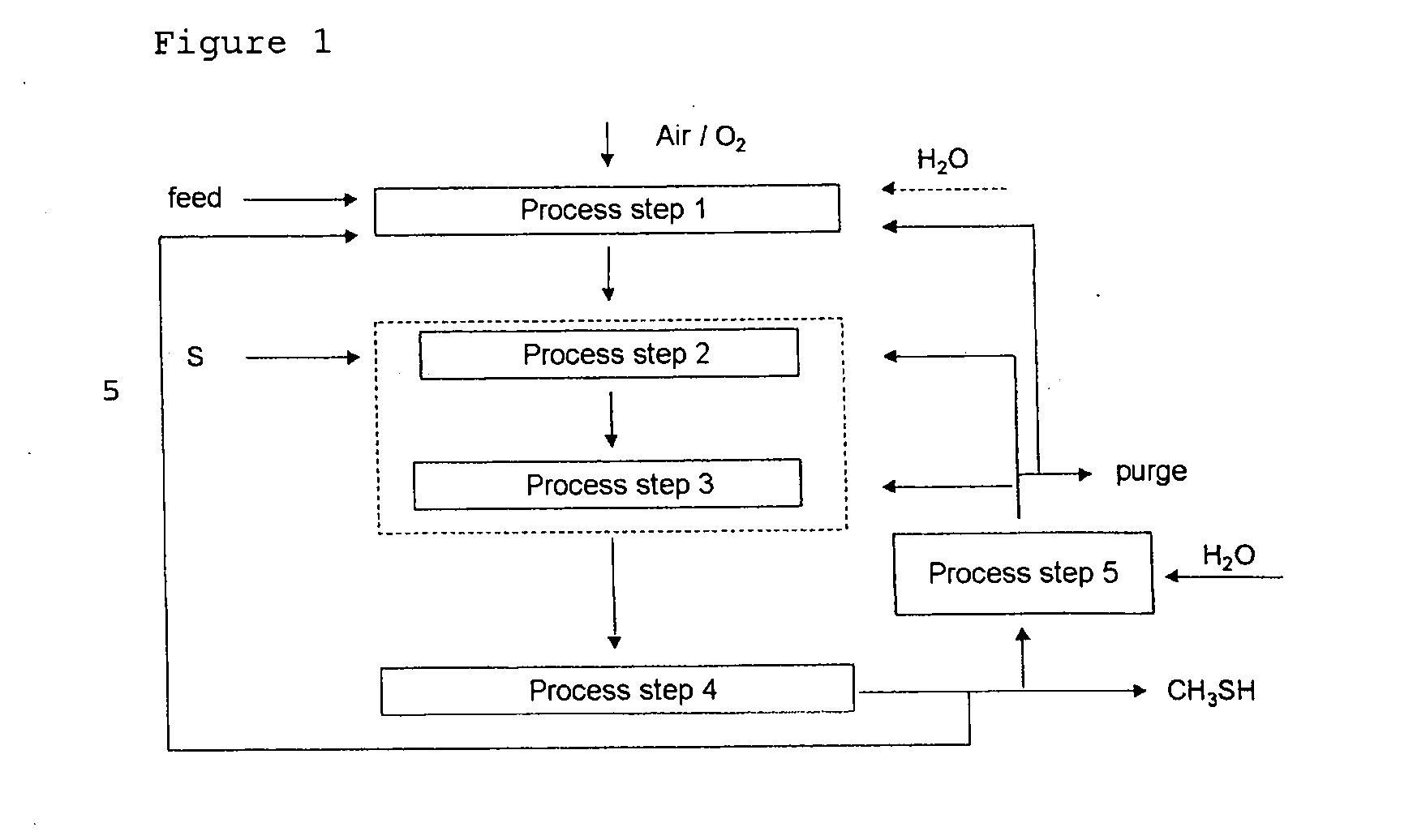[0037]The overall selectivity for methyl mercaptan can be increased by recycling carbon-, hydrogen- and / or sulfur-containing compounds into the first, second and / or third process step. Preference is given to recycling carbon- and hydrogen-containing compounds (e.g., hydrocarbons), other sulfur-containing compounds (e.g., polysulfides and
carbon disulfide), and byproducts (e.g., water), into the first process step. Preference is given to recycling carbon oxides, hydrogen,
carbonyl sulfide and
hydrogen sulfide into the second and / or third process step. A particular
advantage of the present invention is that polysulfides and toxic carbon disulfide occur with selectivities of less than 1%, and consequently may be recycled into the process without having to be separated and / or disposed of in a technically complicated and costly manner.
[0038]As well as methyl mercaptan and water, the gaseous mixture of the third process step comprises unconverted
carbon dioxide (CO2),
carbon monoxide (CO), hydrogen (H2) and
hydrogen sulfide (H2S) starting materials, byproducts, such as
carbonyl sulfide,
methane,
dimethyl sulfide, and small amounts of polysulfides, such as
dimethyl disulfide, and toxic carbon disulfide. Unreacted hydrocarbons, as well as gases which are
inert in the context of the reaction, for example
nitrogen, are also present in the gaseous mixture of the third process step.
[0039]The methyl mercaptan thus formed is removed from the gaseous mixture in the fourth process step, for example in several
distillation and wash columns at temperatures between 10° C. and 140° C., as described in DE 1768826.
Carbon dioxide (CO2),
carbon monoxide (CO), hydrogen (H2) and
hydrogen sulfide (H2S), byproducts, such as carbonyl
sulfide,
methane,
dimethyl sulfide, and small amounts of polysulfides, such as
dimethyl disulfide, and toxic carbon disulfide are recycled into the first, second and / or third process steps.
[0040]Advantageously, the return gas of the optional fifth process step is reacted with water, preferably catalytically, in manner such that the return gas primarily comprises
carbon dioxide (CO2),
carbon monoxide (CO), hydrogen (H2) and hydrogen
sulfide (H2S) as main components.
[0041]The economic viability of the inventive process is advantageously increased in that complicated and costly removal of potential catalyst poisons, for example sulfur-containing compounds and elemental sulfur, is not needed prior to the metered addition of feedstocks into the first and / or second process steps. Similarly, the removal of such compounds after the reaction in the first process step is likewise unnecessary. These substances can be fed directly into the second process step together with the reaction gases, without further workup and compression thereof, which constitutes a significant cost
advantage with regard to the capital and operating costs of the process. Thus, costly desulfurization of the reactant mixture and
product gas mixture of the first process step is not required. Advantageously, sulfur or sulfur-containing slags which may be obtained as byproducts of the first process step can be fed directly in
solid, liquid or gaseous form as a reactant to the second process step. Gases that are obtained from offgas streams of power plants for generating energy, manufacturing plants for producing
chemical products directly or via separation techniques, or those generated during biological processes, including for example degradation or
metabolism, can be fed directly into the second process step. These gas mixtures may comprise hydrocarbons, carbon oxides, sulfur and
nitrogen compounds as main components in a total concentration of 5-90 vol. % in addition to other substances, and may be fed into the first, second and / or third process steps.
[0042]The gas mixture can be converted in the second process stage, optionally with use of a catalyst, by reaction with liquid or gaseous sulfur in a single-stage or multistage process step. In the second process step, full conversion of hydrogen is not attempted. The reaction is performed such that, after the completion of the reaction, the
molar ratio of CO2 / CO / H2 / H2S is from 1:0.1:1:1 to 1:1:10:10, preferably from 1:0.1:4:4 to 1:1:1:1. Advantageously, the gas mixture obtained from the first process step is at a pressure of at least 5 bar and can be fed directly without further compression into the second process step. This constitutes a significant cost
advantage, since it is possible to dispense with a compressor stage with high capital and operating costs. The gaseous mixture obtained from the second process step is subsequently fed into the third process step without further compression and workup. An optional apparatus for removing elemental sulfur or sulfur-containing compounds may be connected upstream of this process step. The conversion to methyl mercaptan is effected in the third process step over catalysts.
 Login to View More
Login to View More 

